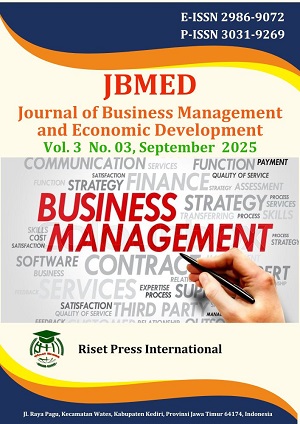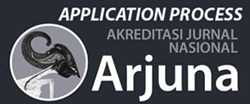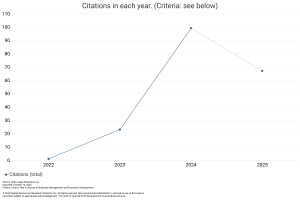Efficiency of Hybrid Maize Farming at the Household Scale in Drylands
DOI:
https://doi.org/10.59653/jbmed.v3i03.1986Keywords:
Production efficiency, hybrid corn, small-scle farmers, drylandsAbstract
Corn as a pillar of the household-scale farmer economy not only serves as a source of food, but also as animal feed and industrial raw material. However, the productivity of hybrid corn in the drylands of Jetak Village (4-7 tons/ha) is still much lower than in other areas (8-10 tons/ha), indicating inefficient use of inputs. This study measured technical, allocative, and economic efficiency among 96 farmers using the Cobb-Douglas production function with stratified random sampling: <0.5 ha (n=33), 0.5-1 ha (n=30), and >1 ha (n=33). NPK fertilizer consistently dominated productivity (elasticity 0.318-0.394; p<0.01) at all scales. Technical efficiency increased from 0.846 (small land) to 0.879 (large land), indicating a productivity gap of 12-15%. Economic efficiency remains suboptimal (0.619-0.688) with a potential for improvement of 31.2%. Allocative analysis shows the highest NPM/Px ratio for urea fertilizer (5.81) on large-scale land, while labor is over-utilized (NPM/Px=0.80). Contribution of the study: identification of scale-based efficiency thresholds for dryland—expansion of critical land for small farmers (NPM/Px=14.17), nitrogen intensification for medium-sized land, and labor restructuring for large land areas. Interventions should focus on NPK optimization and precision fertilization.
Downloads
References
Abate, T. (2023). Determinants of technical efficiency of maize production in Africa: A meta-analysis. Heliyon, 9(3), e14689. https://doi.org/10.1016/j.heliyon.2023.e14689.
Ali, A., & Bhattacharjee, B. (2023). Nutrition security, constraints, and agro-diversification strategies of neglected and underutilized crops to fight global hidden hunger. Frontiers in Nutrition, 10, 1144439. https://doi.org/10.3389/fnut.2023.1144439.
Alemu, G., Angasu, B., & Sime, N. (2022). Economic Efficiency Of Smallholder Farmers In Maize Production: The Case Of Arsi Negelle District, Oromia National Regional State, Ethiopia. 11 (2)(August), 98–104. https://doi.org/10.11648/j.jwer.20221102.14.
Albahri, G., Alyamani, A. A., Badran, A., Hijazi, A., Nasser, M., Maresca, M., & Baydoun, E. (2023). Enhancing essential grains yield for sustainable food security and bio-safe agriculture through latest innovative approaches. Agronomy, 13(7), 1709. https://doi.org/10.3390/agronomy13071709.
Badan Pusat Statistik. (2025). Mid year population (thousand people), 1960–2025. Badan Pusat Statistik. https://www.bps.go.id/en/statistics-table/2/MTk3NSMy/mid-year-population--thousand-people-.html.
Badan Pusat Statistik. (2025). Luas panen dan produksi jagung di Indonesia (hasil KSA amatan April 2025). Badan Pusat Statistik. https://assets.dataindonesia.id/2025/08/07/1754529970455-49-6.-Berita-Resmi-Statistik-Luas-Panen-dan-Produksi-Jagung-Juni-2025.pdf.
Bahtiar, B., Zanuddin, B., & Azrai, M. (2020). Advantages of Hybrid Corn Seed Production Compared to Corn Grain. International Journal of Agriculture System, 8(1), 44. https://doi.org/10.20956/ijas.v8i1.2327.
Beding, P. A., Lewaherilla, N. E., Lestari, R. H., & Tirajoh, S. (2023). Analisis Potensi Pengembangan Komoditas Jagung Di Wilayah Perbatasan Nkri – Png Kabupaten Keerom Papua. SEPA: Jurnal Sosial Ekonomi Pertanian dan Agribisnis, 20(2), 162. https://doi.org/10.20961/sepa.v20i2.52339.
Badan Pangan Nasional. (2024). Rencana aksi Badan Pangan Nasional. Badan Pangan Nasional. https://esakip.badanpangan.go.id/dok/pk/dok_202411753451491.pdf.
Dewi, R. S., Hidayatullah, M., & Suryani, E. (2022). Potensi dan pengembangan jagung hibrida di Indonesia. Jurnal Agronomi Indonesia, 50(1), 45–58. https://doi.org/10.47701/sintech.v3i1.2518
Dong, C., & Gao, J. (2025). Modern series methods in econometrics and statistics. Springer Singapore. https://doi.org/10.1007/978-981-96-2822-3.
Erenstein, O., Jaleta, M., Sonder, K., Mottaleb, K., & Prasanna, B. M. (2022). Global maize production, consumption and trade: Trends and R&D implications. Food Security, 14(5), 1295–1319. https://doi.org/10.1007/s12571-022-01288-7.
Erenstein, O. (2022). Role of staple cereals in human nutrition: Sustainably and diversely agri-food systems and diets. Food Research International, 156, 111264. https://doi.org/10.1016/j.foodres.2022.111264.
FAO, IFAD, UNICEF, WFP, & WHO. (2024). The state of food security and nutrition in the world 2024: Financing to end hunger, food insecurity and malnutrition in all its forms. Food and Agriculture Organization of the United Nations (FAO). https://doi.org/10.4060/cd1254en.
Hansen, B. E. (2022). Econometrics. Princeton University Press. ISBN 978-0691235899.
Johansson, E., Prieto-Linde, M. L., & Östman, A. (2024). Wheat – Current contribution to food security, human nutrition and food products, and needs for improvement. Frontiers in Nutrition, 11, 1393357. https://doi.org/10.3389/fnut.2024.1393357.
Kasmini, L. (2024). Identifikasi Jenis Tumbuhan Sebagai Sumber Kehidupan Berdasarkan Dari Variasi Gizi Dan Nutrisi: Discovery Learning Pada Sekolah Dasar. Journal Visipena Special Issue, 12–18. https://doi.org/10.46244/visipena.vi.2536.
Konate, L., Badu-Apraku, B., Coulibaly, M., Menkir, A., Nasser Laouali, M., Meseka, S., & Mengesha, W. (2023). Agronomic performance and yield stability of extra-early maturing maize hybrids in multiple environments in the Sahel. Heliyon, 9(11), e21659. https://doi.org/10.1016/j.heliyon.2023.e21659.
Li, Z., Zhang, J., & Song, X. (2024). Breeding Maize Hybrids with Improved Drought Tolerance Using Genetic Transformation. International Journal of Molecular Sciences, 25(19). https://doi.org/10.3390/ijms251910630.
Lowder, S. K., Bhalla, G., & Davis, B. (2025). Decreasing farm sizes and the viability of smallholder farmers: Implications for resilient and inclusive rural transformation. Global Food Security, 45, 100854. https://doi.org/10.1016/j.gfs.2025.100854.
Mavroeidis, A., Roussis, I., & Kakabouki, I. (2022). The role of alternative crops in an upcoming global food crisis: A concise review. Foods, 11(22), 3584. https://doi.org/10.3390/foods11223584
Ojuederie, O. B., et al. (2024). Editorial: Neglected and underutilized crop species for sustainable food and nutritional security: Prospects and hidden potential. Frontiers in Plant Science, 15, 1358220. https://doi.org/10.3389/fpls.2023.1358220.
Palus, F. T., Pudjiastuti, A. Q., & Yoga, T. (2025). Allocation of input use in dryland chili farming of Kelompok Tani Hutan Panderman, Batu City. Journal of Business Management and Economic Development, 3(3), 945–957. https://doi.org/10.59653/jbmed.v3i03.1869.
Purba, N. H., & Krishnaswamy, K. (2025). Exploring the potentials of neglected underutilized crops (NUCs): an integrative review for developing a sustainable food system model. npj Science of Food, 9(1), 199. https://pmc.ncbi.nlm.nih.gov/articles/PMC12485001.
Purnawan, E., Brunori, G., & Prosperi, P. (2021). Financial support program for small farmers, and its impact on local food security: Evidence from Indonesia. Horticulturae, 7(12), 546. https://doi.org/10.3390/horticulturae7120546.
Prasetyo, R., Sari, M. K., & Lestari, Y. K. (2024). Penguatan ekosistem jagung: Isu, tantangan, dan kebijakan. Policy Brief Pertanian, Kelautan, dan Biosains Tropika, 6(1), 749-753. https://doi.org/10.29244/agro-maritim.0601.749-753.
Rejekiningrum, P., Apriyana, Y., Sutardi, Estiningtyas, W., Sosiawan, H., Susilawati, H. L., Hervani, A., & Alifia, A. D. (2022). Optimising water management in drylands to increase crop productivity and anticipate climate change in Indonesia. Sustainability, 14(18), 11672. https://doi.org/10.3390/su141811672.
Ruzhani, F., & Mushunje, A. (2025). Technical efficiency in agriculture: A decade-long meta-analysis of global research. Journal of Agriculture and Food Research, 19, 101667. https://doi.org/10.1016/j.jafr.2025.101667.
Saccone, D., Mazzocchi, M., & Corsi, S. (2025). Global food security in a turbulent world: Reviewing the role of cereals in food systems. Agricultural & Food Economics, 13(1), Article 3. https://doi.org/10.1186/s40100-025-00388-0.
Singamsetti, A., Zaidi, P. H., Seetharam, K., Vinayan, M. T., Olivoto, T., Mahato, A., Madankar, K., Kumar, M., & Shikha, K. (2023). Genetic gains in tropical maize hybrids across moisture regimes with multi-trait-based index selection. Frontiers in Plant Science, 14, 1147424. https://doi.org/10.3389/fpls.2023.1147424.
Tumuri, A., Geleta, D., & Sime, G. (2024). Technical efficiency of maize production and their determinants among smallholder farmers in Ethiopia: A case study in Sidama Region. Cogent Food and Agriculture, 10(1), 2392045. https://doi.org/10.1080/23311932.2024.2392045.
Zebua, A., Waruwu, H., Telaumbanua, A., & Laoli, A. (2023). Analisis pertumbuhan tanaman jagung hibrida sebagai pakan ternak di Desa Olora Kota Gunungsitoli. Habitat, 2(2), 1–10. https://doi.org/10.62951/habitat.v2i2.50.
Downloads
Published
How to Cite
Issue
Section
License
Copyright (c) 2025 Yohanes Fischer Tallo, Agnes Quartina Pudjiastuti, Jatmiko Setiaji

This work is licensed under a Creative Commons Attribution-ShareAlike 4.0 International License.
Authors who publish with this journal agree to the following terms:
- Authors retain copyright and grant the journal right of first publication with the work simultaneously licensed under a Creative Commons Attribution-ShareAlike that allows others to share the work with an acknowledgement of the work's authorship and initial publication in this journal.
- Authors are able to enter into separate, additional contractual arrangements for the non-exclusive distribution of the journal's published version of the work (e.g., post it to an institutional repository or publish it in a book), with an acknowledgement of its initial publication in this journal.
- Authors are permitted and encouraged to post their work online (e.g., in institutional repositories or on their website) prior to and during the submission process, as it can lead to productive exchanges, as well as earlier and greater citation of published work (See The Effect of Open Access).





























